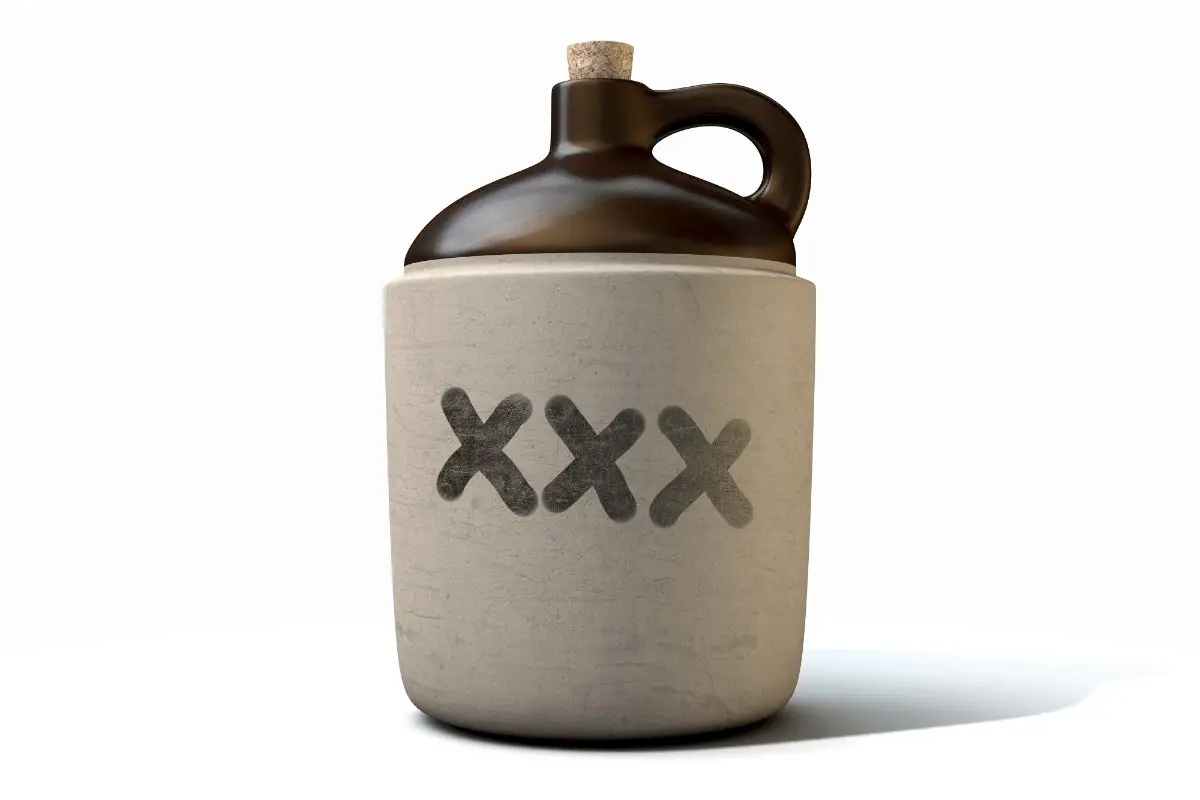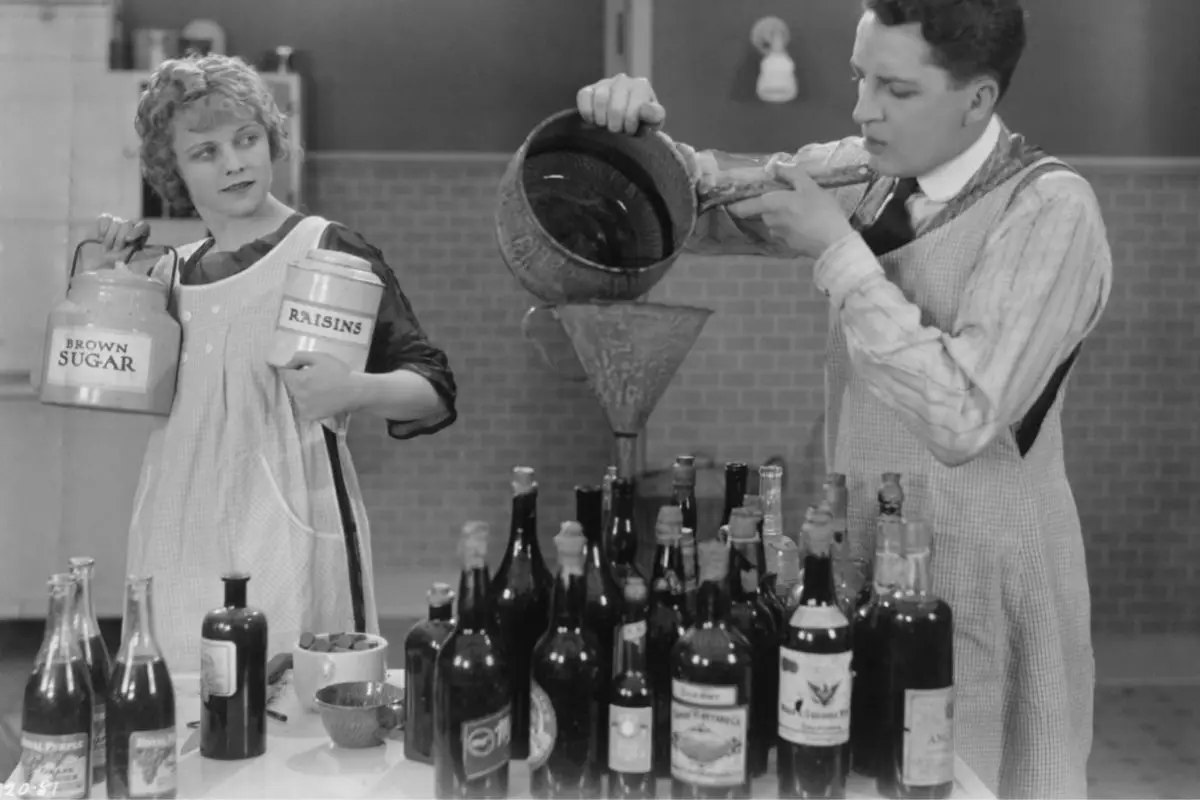Most people have heard about this alcoholic spirit at some point, but not everyone knows what it really is.
Popularly known for being illegal, and being particularly strong to drink due to its high alcohol percentage, moonshine has truly earned a reputation for itself over the centuries.

Moonshining – the general term for producing moonshine, or illicit liquor – can be traced as far back in history as the mid-17th century.
Although the product being produced today does not quite follow the same formula as the original distillate, it still contains many of the same characteristics, and the legend of this American beverage lives on.
In this article, we will be answering all of your questions about moonshine.
So, let’s get into it.
What Is Moonshine?
Moonshine is a term used for strong, illegally produced alcoholic spirits. It is sometimes known as ‘white lightning’, ‘white whiskey’, or ‘mountain dew’ (not to be confused with the soda brand).
These days, the word ‘moonshine’ is thrown around a lot, being used by distillers who produce their own brand of particularly strong alcohol.
While the formula they use is not the same as the original moonshine from the olden days, they still use the name, and the term is often used interchangeably with both types of alcohol.
The reason certain alcohol manufacturers use this term is for marketing purposes. A lot of people want to try moonshine, due to its reputation of being such a strong and unique drink.
There are two main ways that moonshine production works: it is usually created using a still, or through distilling methods.
A still is a machine used to extract alcohol from fermented grain mash. A still is typically made out of copper tubing filled with water. Distillation, which involves heating up sugarcane juice until it evaporates into alcohol, is another method of producing alcohol.
The original recipe for moonshine consisted of combining fermented sugar and mashed up grain, which created ethanol. This was then distilled using an open pot still.
Sometimes the ethanol would be frozen, and then separated from the ice, to produce higher levels of concentration: a process known as fractional crystallization.
The ABV of moonshine can reach up to 95 percent. In the United States, however, alcohol cannot legally be distilled to more than 85 percent, so moonshine of this potency would be illegal to create and consume.
Overall, moonshine is a name generally given to alcohol that is illegally homemade, and is very strong.
Is Moonshine Illegal?
Moonshine is illegal in many parts of the world, including the United States, as well as certain parts of Europe.
The reason for this is simple: it is not just the moonshine itself that is illegal, but rather, the overall activity of distilling alcohol. Therefore, there is no way to regulate its quality. This leads to a lot of unsafe moonshine being sold.
There have been several cases of people drinking moonshine and dying, or suffering major bodily defects, since its alcohol content is much higher than what is found in beer or wine.
Additionally, moonshine makers often use cheap ingredients and add harmful additives to make their product more potent. They may also cut corners to save money. Ingredients sometimes used to create moonshine include gasoline, paint thinner, antifreeze, and other chemicals.
These substances are poisonous, and can cause serious health issues if consumed.
According to federal rules in the US, the production of illegally distilled moonshine is an offense that may result in the offender having to serve up to 5 years in prison, or pay a fine of up to $10,000. Sometimes, the offender may be given a prison sentence and a fine.
The Entire History Of Moonshine

Moonshine is one of the oldest types of alcohol. The first recordings of this form of alcohol dates back to 18th century England: during this time, it was labelled ‘clear, unaged whiskey’. It was popular in Great Britain, and certain parts of the US.
From the early days of American history, people were looking for ways to enjoy alcohol without paying taxes. They made their own whiskey, beer, wine, and brandy. They drank it straight, mixed it with water, and made cocktails out of it.
In 1793, Congress passed a law requiring that distilled spirits be taxed, and distillers had no choice but to turn to illegal methods to avoid taxation. However, there was a loophole: people could still make homemade moonshine. They just couldn’t sell it to consumers legally.
In the 1920s, Prohibition in the United States began, making it illegal to sell alcoholic beverages. During this period, moonshine was served at night to avoid suspicion from the police, and it quickly became popular amongst the masses due to its low price and availability.
In the United States, after the Prohibition era had ended, a law was passed that made it illegal to distill alcohol at home. This meant that, while other types of alcohol were now legal to purchase and consume, moonshine was still considered illegal.
In 1978, a new law was passed that allowed people to home-brew certain kinds of alcohol, such as wine and beer. Moonshine, however, remained illicit.
These laws never stopped the ‘moonshiners’ – a term used for moonshine producers – and, so, moonshine continued to thrive under the radar.
To this day, moonshine is still being illegally produced in some areas of the world.
The Effects Of Consuming Moonshine
As we previously mentioned, one of the reasons that moonshine has remained illegal over the years is due to the many dangers of consuming it. A singular jar of moonshine can cause several bad side effects if consumed.
Many amateur distillers use cheap ingredients to make their product, including poisonous chemicals. If consumption doesn’t kill the drinker, it can cause many effects that can harm their bodies.
Bad moonshine has been known to make people go blind, in some cases. This is due to the usage of toxic chemicals to create their product, such as acetone and methanol.
In other cases, bad moonshine can cause serious neurological damage to a person, meaning that they have lost control of bodily functions, or even become paralyzed.
Other side effects include vomiting, diarrhea, headaches, dizziness, seizures, hallucinations, and even death.
Any particularly strong, high-proof liquor can cause health issues when consumed in large quantities, including whiskey, vodka, and gin. This difference between these spirits and illegally distilled moonshine is that they are often professionally manufactured with no toxic chemicals added.
These spirits have been approved to sell and consume, whereas moonshine, being homemade illegally, is made under no health and safety regulations.
If a person were to drink illicitly distilled moonshine, they wouldn’t know what ingredients were used to create it, whereas if they were to drink from a bottle of branded whiskey, they could check the label to see what was used to create it.
Even if they didn’t check the label, they can feel safe knowing that the drink was approved for consumption by the government.
Final Thoughts
Overall, the term moonshine refers to illegal alcohol made by distilling grain or corn mash. It can also refer to illegal alcohol made by fermenting fruit juices.
Some people may use the term moonshine to refer to the illegal liquor that comes in bottles with labels that resemble authentic whiskey labels.
Although moonshine is not always legal, it can be very popular amongst those who drink illegally because it is often cheaper than other types of alcoholic beverages.
It is recommended that you avoid drinking illegally distilled moonshine at all costs, as it may contain harmful toxins that can negatively affect your body. Instead, try to find an authentic whiskey brand that uses only natural ingredients.
We hope we have answered all your questions about moonshine.
- Vevor Still Instructions - June 12, 2023
- Best Proofing Parrots For Home Distilling - February 1, 2023
- What Is A Porter Beer? - June 12, 2022
